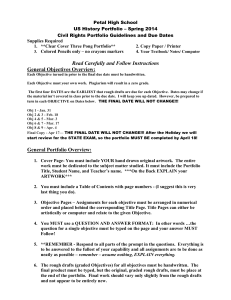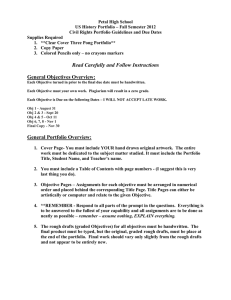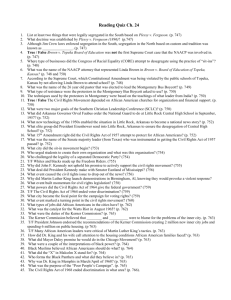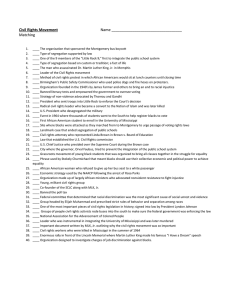Civil Rights Portfolio Rationale
advertisement
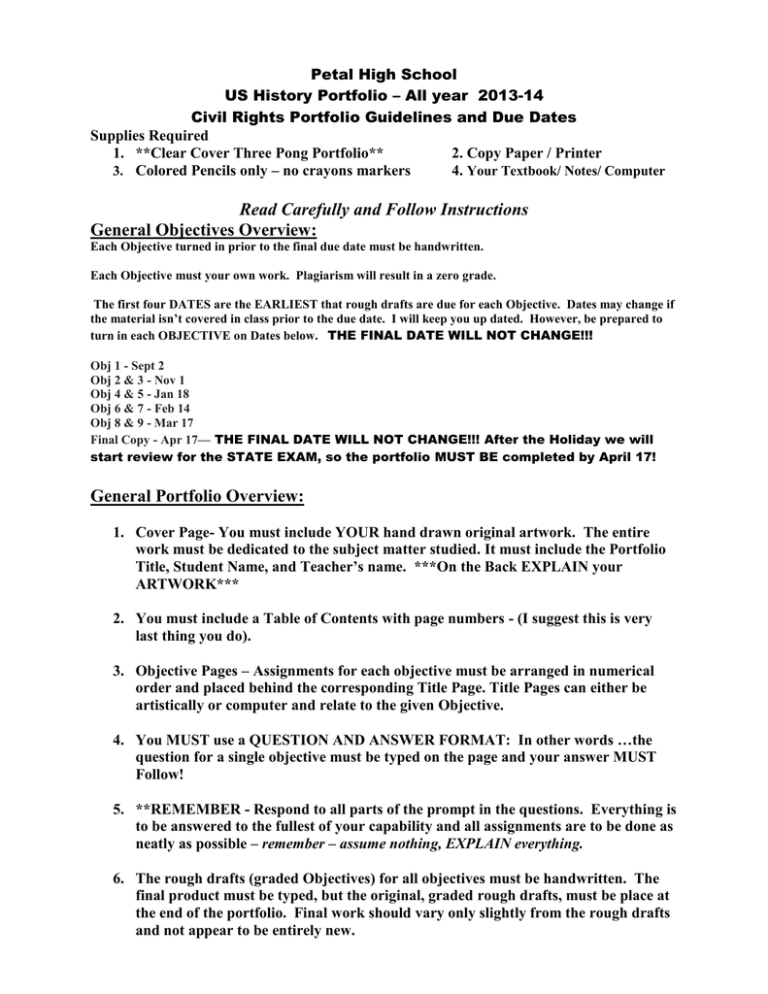
Petal High School US History Portfolio – All year 2013-14 Civil Rights Portfolio Guidelines and Due Dates Supplies Required 1. **Clear Cover Three Pong Portfolio** 2. Copy Paper / Printer 3. Colored Pencils only – no crayons markers 4. Your Textbook/ Notes/ Computer Read Carefully and Follow Instructions General Objectives Overview: Each Objective turned in prior to the final due date must be handwritten. Each Objective must your own work. Plagiarism will result in a zero grade. The first four DATES are the EARLIEST that rough drafts are due for each Objective. Dates may change if the material isn’t covered in class prior to the due date. I will keep you up dated. However, be prepared to turn in each OBJECTIVE on Dates below. THE FINAL DATE WILL NOT CHANGE!!! Obj 1 - Sept 2 Obj 2 & 3 - Nov 1 Obj 4 & 5 - Jan 18 Obj 6 & 7 - Feb 14 Obj 8 & 9 - Mar 17 Final Copy - Apr 17— THE FINAL DATE WILL NOT CHANGE!!! After the Holiday we will start review for the STATE EXAM, so the portfolio MUST BE completed by April 17! General Portfolio Overview: 1. Cover Page- You must include YOUR hand drawn original artwork. The entire work must be dedicated to the subject matter studied. It must include the Portfolio Title, Student Name, and Teacher’s name. ***On the Back EXPLAIN your ARTWORK*** 2. You must include a Table of Contents with page numbers - (I suggest this is very last thing you do). 3. Objective Pages – Assignments for each objective must be arranged in numerical order and placed behind the corresponding Title Page. Title Pages can either be artistically or computer and relate to the given Objective. 4. You MUST use a QUESTION AND ANSWER FORMAT: In other words …the question for a single objective must be typed on the page and your answer MUST Follow! 5. **REMEMBER - Respond to all parts of the prompt in the questions. Everything is to be answered to the fullest of your capability and all assignments are to be done as neatly as possible – remember – assume nothing, EXPLAIN everything. 6. The rough drafts (graded Objectives) for all objectives must be handwritten. The final product must be typed, but the original, graded rough drafts, must be place at the end of the portfolio. Final work should vary only slightly from the rough drafts and not appear to be entirely new. Civil Rights Portfolio Rationale In 2006 the Mississippi Legislature passed Senate Bill 2718 SENATE BILL NO.2718 AN ACT TO DIRECT THE STATE BOARD OF EDUCATION TO MAKE CIVIL RIGHTS EDUCATION A MANDATORY PART OF THE K-12 CURRICULUM INSTRUCTION IN THE STATE OF MISSISSIPPI; The Senate Bill became law under the MS Code 37-13-193 The Mississippi Department of Education responded to the MS Code 37-13-193 by adding a framework strand of Civil Rights / Human Rights to the new 2011 Curriculum. “The framework is comprised of five content strands: Domestic Affairs, Global Affairs, Civil Rights / Human Rights, Economics, and Culture. The content is expected to be taught by infusing social studies skills into the pedagogy of the course.’ -From the 2011 Social Studies Curriculum The 2010-2011 Mississippi Subject Area Test for U.S. History will be aligned to the above strands. (See the entire Social Studies at the Mississippi Department of Education website) Students’ performance concerning their historical knowledge of all the Framework strands, competencies, objectives, and concepts associated with United States from the Post-Reconstruction Period to the Present accumulate on the Eleventh Grade MSAT. Unlike other subject areas (i.e.; Math, English and Science), Mississippi only tests social studies in the Eleventh Grade. The Civil Rights Portfolio Project is a significant work to meet the mandatory standards set by the State Curriculum. According to the Standards, students are required to utilize their historical knowledge to: 4a. Analyze the issues that gave rise to the Civil Rights Movement from post-reconstruction to the modern movement. (DOK 3) 4b. Trace the major events of the modern movement and compare and contrast the strategies and tactics for social change used by leading individuals/groups. (DOK 2) 4c. Analyze the response of federal and state governments to the goals (including but not limited to ending de jure and de facto segregation and economic inequality) of the Civil Rights Movement. (DOK 3) 4d. Evaluate the impact of the Civil Rights Movement in expanding democracy in the United States. (DOK 3) 4e. Compare and contrast the goals and objectives of other minority and immigrant groups to those of the Civil Rights Movement led predominantly by African-Americans. (DOK 2) 4f. Cite and analyze evidence of the political, economic, and social changes in the United States that expanded democracy for other minority and immigrant groups. (DOK 3) 7a Examine cultural artifacts (including but not limited to visual art, literature, music, theatre, sports) to contextualize historical developments. (DOK 2) Objective 1: The Long March Forward (Standards: MS Framework Civil Rights41,b,c,d,e, / Common Core Standards-11th 2,3,9,/IHL 1.1, 2.2, 4.2, 5.1, 5.2, 5.3) Historical Background: Between 1865 and 1910, African Americans transformed from an enslaved people in search of identify to a nationalistic movement seeking the rights and liberties that were so eloquently stated in the Declaration of Independence that “all men are created equal.” A. Your Task: Write an organized factual essay with a well-developed thesis that answers the following questions. By answering these questions you will trace the African American transformational experience from 1865 to the Plessy decision. Including Addressing legalisms (court cases, laws, etc.), economic conditions, philosophies, leaders, movement of people, and other factors that contributed or obstructed the rise of African American nationalism during the given time period. (State 4a, 4b, 4c) (Core 1. Why weren’t many of the freed slaves of the South actually freed by the Emancipation Proclamation? 2. What three constitutional amendments improved the status of African Americans in the US? What changes did these amendments bring? What are the provisions of the 14th amendment? 3. What difficulties did the freedmen face immediately after the war? What was organized by the government to educate former slaves? Why did the government's attempt to redistribute land to freedmen fail? 4. Define the term "disenfranchisement." Explain Three tactics white Southern Democrats used to restrict or control black suffrage in the late 1800s and undermine the civil rights that African Americans had gained during Reconstruction? What were the goals and tactics of the KKK? 5. How did the crop-lien system (Sharecropping) work? Why did it cause such economic hardships for the tenant farmers stuck in that system? How did the crop-lien system overshadow the economic gains made by blacks and poor whites? 6. Explain how Southern whites used lynching to control the black population. How did some whites, both Northern and Southern, respond? What role did Ida B. Wells play in response to the increased horror of lynching? How did Ida B. Wells use her skills to fight discrimination? 7. What was the term for freedmen who migrated to Kansas and the west following the Civil War? What factors pulled them to the Great Plains? Who was their leader? 8. How did the Supreme Court rulings in the Slaughter House cases affect the situation of African Americans in the post Reconstruction South? 9. What were Jim Crow laws? What is the difference between de jure and de facto segregation? List and DESCRIBE five Jim Crow laws that appeared in Southern states during and immediately after Reconstruction. B. As we know, the Supreme Court case Plessy vs. Ferguson 1896 substantially negated the effect of the equal-protection clause of the 14th Amendment? •Write a case brief of the case Plessy v. Ferguson. (Use a Supreme Court Case Study sheet as format). Include the following: Facts of the case, Constitutional Question, Conclusion and Legal impact on De jure segregation. How did the Plessy v Ferguson ruling reaffirm discrimination of African Americans in the United States? (State 4a, 4b, 4c) (Core 9) Objective 2: Harlem Renaissance The Great Migration led many African-Americans to Harlem in New York City. Their “changed situation” blossomed into a movement of cultural celebration in literature, music and artistic expression and enhanced the “Roaring Twenties” decade. The Harlem Renaissance had a significant impact on black culture and consciousness world-wide. Pg 354-363 and old notes Read pg. 848 on The Atlantic Exposition Address. AND pg 229 Comparing Viewpoints. A. Map the Great Migration. Map must include neat and accurate Legend. Include the following. (Don’t forget to title your map including dates). 1. Draw a saxophone and label - Harlem, NYC 2. Draw a trumpet and label– New Orleans, LA 3. Draw a piano and label– Memphis, TN 4. Draw a factory and label each of the following places - Chicago, Detroit, Pittsburg, Cleveland, St. Louis, Buffalo, Boston, Minneapolis, Milwaukee, Kansas City, Cincinnati, and Indianapolis 5. Include Historically accurate arrows diagramming the movement. (State -2a, 4a, 5c) B. By the 1920s three prominent African Americans leaders emerged. Booker T. Washington, W.E.B Dubois and Marcus Garvey. Each differed on how to achieve civil rights. Using the following information complete a Venn Diagram- comparing and contrasting the three leaders. a. Believed in a separate black government b. Wanted Legal Equality c. Placed most emphasis on agriculture d. Edited The Crisis e. Stressed the importance of higher education f. Founded the United Negro Improvement Association g. Accepted social segregation of the races h. Demanded immediate black suffrage i. Wrote the autobiography Up From Slavery j. Stressed the importance of manual labor k. Demanded Immediate integration of the races l. Started the Niagara Movement m. Believed in a gradualist approach to rights for African Americans n. Wanted to see Blacks in professional roles such as doctors, lawyers, and politicians o. Created the National Association for the Advancement of Colored People (NAACP) p. Founded the “Black Star Line” to transport blacks to Africa q. Wanted to see The Talented Tenth rise up r. focused on vocational training to help achieve economic independence. s. Founded the Tuskegee Institute t. Edited the Crisis u. Encourage blacks to start their own businesses which would serve other blacks v. Was arrested and deported to Jamaica w. Believed in the Atlanta Compromise x. Authored the Souls of Black Folks in 1904 C. (1) Print an illustration of Song of the Towers, and under write a paragraph reflecting the importance of Aaron Douglas to African-American culture. (State -7a) (Core -6) (2) Bullet the chorological (that means put it in order) History of the Great Migration as seen in the painting by Aaron Douglas. (A good description of the painting will have several bulleted descriptors. It is possibility to list twenty.) (State 7.a) D. The “poet laureate” of the Harlem Renaissance was Langston Hughes. Under the poem I Too Sing America, answer the following questions. (1) Do you think the theme of this poem is positive or negative? Why or Why not? (2) Why is the darker brother sent to the kitchen to eat? (3) How does the character in the poem respond to his treatment? Why do you think Langston chose to respond this way? E. Duke Ellington, Louis Armstrong, Josephine Baker, and many others embraced the new sound of jazz that arrived in the northern industrial centers by way of the Great Migration. They performed in such venues as the Cotton Club / Apollo Theater . Jazz allowed African Americans to express a new sense of hope and pride. •How did jazz spread from its roots in the South to the North in the 1920s? •How did Jazz blend cultural influences and cross-cultural divides? ***Include how THE PERFOMERS AND THE CLUBS symbolized depth and richness of African American Culture***** Cite source on this one. (State-7.d, 7.e) Objective 3: The Great Depression and World War II In 1929, the American Stock Market crashed and triggered the Great Depression. A ten year period of unparallel economic despair swept the nation. The Great Depression ended due to the industrial economic output that was required to fight against Hitler and his allies. During the Depression, African-Americans were championed by the President’s wife, Eleanor Roosevelt, who was instrumental in organizing the “Black Cabinet” that served as informal advisors to the president. A. (Information only)- During the Depression, a new labor union organized called the Congress of Industrial Organizations (CIO). It was organized under the leadership of John L. Lewis. The union differed from the traditional AFL because it would accept women, African-Americans, skilled and unskilled workers. Under the CIO, an African-American labor union also organized called the Brotherhood of Sleeping Car Porters, under the leadership of A. Philip Randolph. After the war, jobs increased in defense related industries. (State 5b) Beginning with the above information, create a fictional chronological in-depth dialogue (like a play) between FDR and Randolph that led to the Executive Order 8802. (Include information about discrimination in the defense industry & the canceled march for jobs). pg 473-481 (State 4b) B. The issuance of Executive Order 8802 was a “win” in what became known as the "Pittsburgh Courier's" Double V Campaign in 1942. Print out the Double “V” emblem. Describe its two goals –Why were these goals necessary use details. (State 4d) (Core 3, 6) C. After the war and the death of FDR, President Truman made the quest for African-American civil rights a cornerstone of his Fair Deal domestic policy. He also issued Executive Order 9981. Under an original document (headline, political cartoon of 9981) explain the steps Truman took to end racial discrimination in the federal government? Explain the order. When was the last segregated troop? (State 1b, 4c) (Core 1, 2) D. Individual African-Americans also began to challenge the race barrier. One of the best examples was Jackie Robinson. Under a copy of one of his “cards,” explain why Jackie Robinson was an important figure in the struggle for civil rights and his contribution to Americana and describe his accomplishments/awards won. (State 4b, 7a, 7e) Core 5) Objective 4: With all Deliberate Speed! pg 578-613. The 1950s proved to be a pivotal decade in African-American history. Reacting to Black Nationalism, outstanding war records, organizational leadership from unions and the NAACP, and the influence of black churches and colleges positioned the AfricanAmerican community to claim their future. (State 4a) A. In 1954, the NAACP argued it’s most important case before the Supreme Court, Brown vs. the Board of Education of Topeka Kansas. Under a 1954 picture of Linda Brown, brief the Brown case. Write a case brief of the case Brown v. Board of Education II. Include the following: Facts of the case, Constitutional Question, Conclusion, and Legal impact on De jure segregation B. The Brown Case introduced Thurgood Marshall to mainstream America. What was his role in the case? What was his winning strategy in the case? (hint: the Dr. Clark and his dolls) How was his future position of status propelled by the case? (hint: 1967) C. (Information only) The Warren Court could only interpret the Constitution (specifically the 14th Amendment in this case). The branch of government that was ultimately responsible for implementing the Brown Case was the executive branch, occupied by President Dwight D. Eisenhower. His “inaction” in Brown and the Emmett Till murder in Mississippi reflected his belief in states’ rights and his preference for limited intervention in state’s affairs by the federal government. ∙How was the murder of Till a reaction to the Brown Case? Include… What happened to Emmitt Till. Why? What was the outcome of the murder case? (State 4a) D. The “game changer” came in 1957 at Central High School in Little Rock, Arkansas. Write a one page “first person” account of the Central High School Crisis. Portray yourself as one of the following: (State 1c) One of the Little Rock Nine (you must give yourself one of their names) Governor Faubus A member of the National Guard President Dwight D. Eisenhower A member of the 101st Air Borne Division Refer to all other bullets in your one-page first-person account of the Crisis. Reference to the other people / groups will determine your understanding of the objective. Objective 5: From Montgomery to Washington The defining individual action in the developing Civil Rights Movement was set in motion by Rosa Parks in Montgomery, Alabama in 1955. She challenged a Jim Crow city ordinance for not standing and letting a white bus rider take her seat. She was promptly arrested for her action. A. The arrest of Rosa Parks triggered immediate action on the part of AfricanAmericans. Newcomer Martin Luther King, Jr. was elected as leader of what was developing into a prolonged boycott of the Montgomery, Alabama transit system. His approach against discrimination proved to be tremendously effective in the long march toward racial equality. Pg 585-587 • Provide a photo of Dr. King under it describe his protest belief. Include the following . . . How did King put his belief in nonviolence into practice in the Montgomery?, How long did the boycott last?, How did the Montgomery bus boycott force the city to change its laws? (State 4a, 4b) (Core 3, 8) B. Along with the already established NAACP and CORE, the Montgomery Bus Boycott gave rise to other organizations seeking African American civil rights including the SCLC (Southern Christian Leadership Conference) and later SNCC (Student Nonviolent Coordinating Committee.) Under a photo illustrating each of the following: Greensboro Sit-in (include names of men who started this Protest) Freedom Rides (include the bombing on the Bus outside Birmingham) Freedom Summer (include Fannie Lou Hamer) Selma March (include the reason why there were 3 Marches) ºWhat did the protesters hope to accomplish? ºWhat protest strategies the organizations (SCLC, SNCC) use in each photo. ºWhat are the results of the protests (was there an Act of Congress or Supreme Court Decision)? (State 4a, 4b, 7c) (Core 1) C. The eloquence of Dr. King’s message transcended the level of understanding of most Americans in the early 1960s. “Injustice anywhere is a threat to justice everywhere” is a sample of his unique ability to explain the uncomplicated. The quote is from the Letter from Birmingham Jail written in April, 1963. Read the entire letter. Find an excerpt that describes to whom is addressing his letter. • Under the excerpt, (not the whole letter) answer the following. º Explain the events of his confinement. º EXPLAIN WHY he is addressing this group. º How does King justify breaking laws as a means of protest? D. THE MARCH ON WASHINGTON –Martin Luther King, Jr., delivered the closing address at the March on Washington. For approximately 20 mins, he mesmerized the crowd with one of the most powerful speeches ever delivered Read or listen the text of Martin Luther’s King’s speech, “I Have a Dream.” Finally, pretend you attended the March on Washington in 1963 and write a diary entry describing the important imagery used by Dr. King in his speech in front of the Lincoln Memorial in Washington in the summer of 1963 AND the key points made by him during the speech. (must be handwritten and must contain one to two pages - you can include two small hand drawn - drawings). (State 4a, 4b, 4c, 7c) (Core 6) Objective 6: A “war of poverty” and a “Great Society” President John Kennedy called for federal support for Civil Rights legislation in his New Frontier domestic programs. An assassin’s bullet delivered by Lee Harvey Oswald in Dallas Texas killed Kennedy just two months after Dr. King voiced his dream. Vice-President Lyndon Baines Johnson, a New Dealer from Texas, became President. In 1964, President Johnson began to address economic problems that developed by the failure of addressing the problems of the elderly, the poor and those affected by a century of racial discrimination. A. In a series of speeches, LBJ declared an “unconditional ___?___ _?_ _ ___?___” and the nation will set its course toward a “_____?_____ _____?______.” B. The centerpiece of the “War on Poverty” was the passage of the Economic Opportunity Act of 1964. It included several community-based antipoverty programs including Head Start and Jobs Corps. In small 2-3 inch squares, define and illustrate what/ who the program helps– you must draw each **DO NOT JUST USE THE PROGRAM’S LOGO - **each according to the below format. (State 4c) Head Start: Write the Definition here XXXXXXXXXXXXXXXXXX XXXXXXXXXXXXXXXXXX XXXXXXXXXXXXXXXXXX YOU illustrate what/who the programs helps. DO NOT USE THE PROGRAM’s LOGO! USE a RULER. XXXXXXXXXXXXXXXXXXXXX C. The centerpiece of LBJ’s Great Society was Medicare and Medicaid. Following the above format, define and illustrate Medicare and Medicaid. (State 1a, 4c) D. To further advance civil rights in the United States, Congress passed the Civil Rights Act of 1964 and the Voting Rights Act of 1965. Following the above format, define and illustrate each. (State 4c) E. Finally in 1964, the Twenty Fourth Amendment was added to the Constitution. Using the above format, define and illustrate the Amendment. (State 4c) F. In 1965, LBJ issued Executive Order 11246 dealing with “Affirmative Action.” Using the above format, define and ILLUSTRATE the concept. (State 4c) G. In 1968, Congress passed the Civil Rights Act of 1968. Following the above format, define and illustrate the Act. (State 4c) Objective 7: The Call for Black Power, Nationalism, and Separatism In the words of Mississippi Freedom Democratic Party leader, Fanny Lou Hamer, “I am sick and tired of being sick and tired …we are threatened daily because we want to live like decent human beings.” Frustrated with the limits of nonviolent protest and electoral party politics, younger activist were also “sick and tired” and found themselves increasingly drawn to militant rhetoric. A. During the 1960s, the Civil Rights Movement became more volatile. The Los Angeles Watts Riots, the Selma March in Alabama, and the assassination of Malcolm X (by a rival Black Muslim group) contributed to the volatility. The Vietnam War also served as a catalyst to turn away from Dr. King’s philosophy of peaceful civil disobedience. In 1967, Johnson established the Kerner Commission. Why was the Report issued by the Kerner Commission so controversial? Do this in bulleted statements. ● Why was the Kerner Commission formed? ● A main recommendation of the report. ● Why were the Kerner Commission’s findings controversial? ●Explain why the Vietnam War contributed to Black militancy in America. C. In 1966, Stokely Carmichael coined the phrase “Black Power!” The Black Power Movement seemingly replaced the philosophy of Dr. King; much like the W.E.B Dubois’ movement replaced the gradualism of Booker T. Washington at the turn of the 20th century. Using a Venn Diagram compare and contrast Dr. King’s Philosophy with that of Stokely Carmichael’s. (Include creation of Black Panthers.) USE RELEVANT DETAILS NOT JUST WORDS OR PHRASES. (use info from pg 602-608 for Stokley Carmichael) Include the following information: brief biographical info organizations he was a member of goals accomplishments relevant quotes Significant events Must include visuals D. On April 4, 1968, Dr. Martin Luther King was assassinated by James Earl Ray in Memphis, Tennessee. As we know from his “Letter from Birmingham Jail” and “I have a Dream Speech,” Dr. King’s words are indelibly written in history for the ages. For us, he has given this phrase: “I have a dream that my four little children will one day live in a nation where they will not be judged by the color of their skin, but by the content of their character.” Objective 8 – Reducing Prejudice and Protecting rights of Minority Groups The African-American Civil Rights Movement empowered others to challenge the status quo of their economic and social circumstances. Create a Five - column chart on a piece of 11 by 17 paper. (I have some in my classroom) Label the columns as follows: “Jewish Americans,” “Native Americans,” “Mexican Americans,” “Handicapped-Americans,” and “Asian Americans” Place the following terms/people in the column that MOST reflects the minority group.(Some Words maybe used in more than one category. Feminism, Caesar Chavez, Betty Friedan, Occupation of Alcatraz, Braceros, The Feminine Mystique The Indian Self-Determination of 1975, Louis Brandeis Migrant Workers, Title IX, Israel, bilingual education, Japanese-American Citizens League, Equal Rights Amendment, Occupation of Wounded Knee, Grape Boycott, Gloria Steinem, Roe v Wade, Chicano Movement, National Organization for Women, United Farm Workers, Latinos, Roe V Wade, Phyllis Schlafly, La Raza Unida, American Indian Movement, Korematsu v United States, Americans with Disabilities Act, Violence Against Women Act of 1994, Equal Pay Act 1963, Title VII of the Civil Rights Act, The Education of All Handicapped Children Act 1975, Anti-Defamation League, Sandra Day O’Conner Objective 9 : Mapping the Movement. Several locations relate to the modern civil rights movement and the struggle for civil rights during the post-World War II era. On a map of the United States label the following: Unless directed otherwise use a black star. MAKE SURE YOU LABEL EVERYTHING!!! Map must include neat and accurate Legend. (Don’t forget to title your map including dates). 1. Mark the following with a yellow × : Money, Mississippi; Birmingham, Alabama; Montgomery, Alabama; Jackson, Mississippi; Memphis, Tennessee; Watts, California; Philadelphia, Mississippi; Greensboro, North Carolina; 2. Use a school house to label - Topeka, Kansas; Little Rock, Arkansas; Ole’ Miss in Oxford, MS 3. Draw a Blue line symbolizing the March from Selma to Montgomery, Alabama 4. Label Washington, D.C.; Atlantic City, New Jersey; Atlanta, Georgia 5. Label Wounded Knee, SD; (Hint AIM) 6. Use a red colored pencil to trace and LABEL the COURSES of the Freedom Riders. 7. Draw a bundle of grapes on Delano, California Make a map legend. Include the following on your legend. For each place you labeled- bullet the importance of the location as it pertains to the fight for Civil Rights. (AKA- WHAT HAPPENED THERE) NOW GO BACK AND RE-READ DIRECTIONS…..
